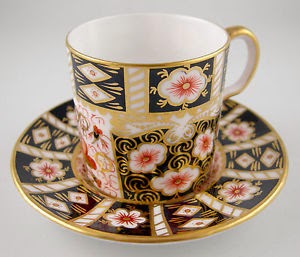part 3 of 3
DERBY CROWN PORCELAIN COMPANY
 |
| CROWN DERBY |
Attractive wares from this period include Parian statuary pieces, delicate eggshell porcelain tea services, fine perforated baskets, and of course, Imari ware. Also look out for decorative items, such as vases, painted with landscapes, fruit, flowers, rich colours and finely gilded, inspired by the popular Victorian taste for Oriental and Asian influences. A 19th century vase, hand-painted with elaborate gilding and decoration, in good condition could be valued at around £3,000- 4,000, particularly if the artist is identifiable.
 |
| CROWN DERBY |
In fact, it is items from this period that are increasing in value in the market at the moment. More fashionable than the early figures, fine tablewares are rising in value, while vases, particularly if they have hand-painted scenes by artists such as Desire Leroy or Cuthbert Gresley, or even earlier artists such as George Robertson, are commanding staggering sums at auction. At Sotheby's, a two-handled vase and cover decorated by Leroy realised £20,700 on an estimate of £15,000-20,000.
Derby porcelain is a traditional and often expensive choice to collect, but enthusiasts are drawn by its quality and beauty. From early figures to 19th century Imari and the exceptional quality of the hand-painting, there are many reasons to collect Derby porcelain. It may not be as fashionable as Clarice Cliff, but the market for Derby will probably prove less fickle, and porcelain vases and tablewares will continue to be a safe and attractive investment.
 |
| CROWN DERBY |
CROWN DERBY TOP TIPS
■ 18th and 19th century trios, comprising a cup, saucer and side plate, are an affordable way to start collecting Derby porcelain. There are many patterns to collect and later sets can be obtained for under £100. Tablewares are rising in popularity at the moment - starting small with individual items of tableware could prove to be a good investment.
■ Very rare early pieces can be identified by the soft paste imitation porcelain used by Planche and a thick, glassy glaze. A distinctive feature to look out for is the narrow band on the base left glaze-free to prevent fusing during firing.
■ Avoid badly worn gilding. The gilding on Derby pieces was quite thick and can come off in chunks. Avoid pieces with large sections of gilding missing. Andrew Dando explains, A teapot stand, for example, with worn gilding in the centre where the teapot would have stood is acceptable wear and tear. If the gilding around the edge has sections missing - avoid buying the piece.
'
■ Chips and cracks should be avoided on tea wares, but small damage and restoration is acceptable and not detrimental to the value of figures.
 |
| CROWN DERBY |
■ Bloor pieces are susceptible to crazing. This is acceptable provided staining has not resulted.
■ Pieces from the Bloor period can often be identified by the 'slapdash' marks. Workers would stamp the mark on the base of a piece with red ink, and then press their thumb on the mark, using the imprint to mark several more pieces. Consequently some marks are quite faded in appearance and some have a thumb-print clearly visible.
■ Modern fakes are not really a problem, although Samson of Paris produced Derby copies from 1870. Some other Continental factories have produced Derby fakes in the 20th century. The copies are generally of early and Bloor period figures. Samson of Paris figures are now collectable in their own right, but not as valuable as real Derby.
 |
| CROWN DERBY |
FURTHER BLOG READING
part 1 ROYAL CROWN DERBY
part 2 ROYAL CROWN DERBY CHINA
part 3 CROWN DERBY
Collectibles Coach
part 2 ROYAL CROWN DERBY CHINA
part 3 CROWN DERBY
Collectibles Coach

No comments:
Post a Comment